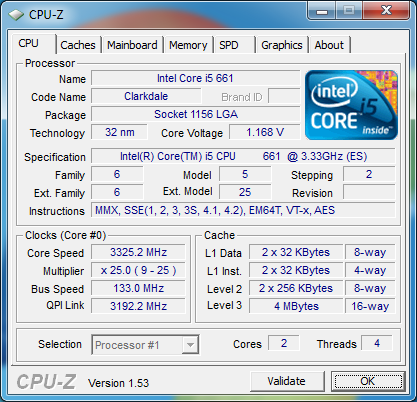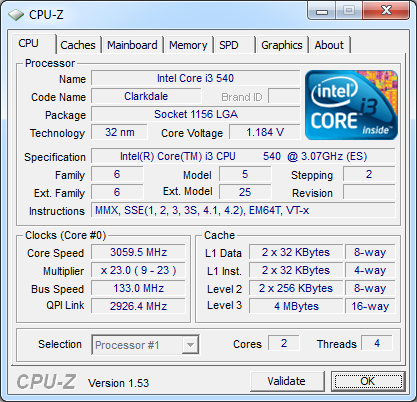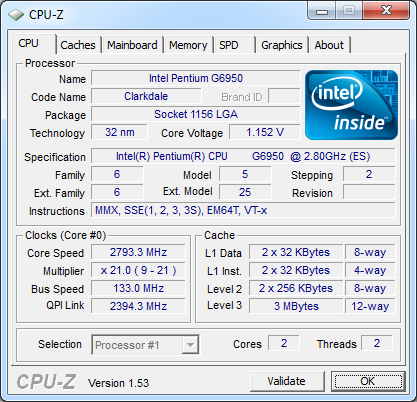Introduction
Almost all of our latest articles are dedicated to new processors Intel, begin with the same thing - a brief reminder of the tick-tock strategy, the long-term plan in accordance with which this manufacturer alternately improves the microarchitecture, then technological process over the past few years. Let's not show originality this time either. Indeed, the desire not to violate previously given obligations is, in fact, the only reason why Intel continues to annually introduce new generations of its products to the market. Since 2006, when Intel first introduced Core microarchitecture, the company maintains leadership in the race for speed - without waiting for a competitor, it plays ahead of the curve, proactively increasing the performance of its processors. The second step, which significantly strengthened Intel's position in the processor market, was the introduction of technology with 45 nm production standards in the next year, 2007. It would seem that it was quite possible to stop there. But the desire to continue to follow the “tick-tock” strategy did not allow the company to slow down further development. Progress continued, and in 2008 year Intel introduced a new Nehalem microarchitecture, represented by Bloomfield and then Lynnfield cores.
But the story doesn’t end there either. The original schedule suggested that 2009 was supposed to be the time for Intel to switch production to the more modern 32nm process technology. Once again, Intel has not backed down from the promises it made several years ago. Although technically 2009 is already over, the release of 32 nm processors began last year, and today these processors are not only announced, but also become available for retail sale (although here, of course, it can be noted that the New Year holidays will make adjustments to the schedule supply of processors to various stores). We are talking about a family of products codenamed Westmere, which includes processors for desktop computers- Gulftown and Clarkdale - and Arrandale Mobile. True, so far the company does not offer all three types of 32-nm models, but only Clarkdale and Arrandale, but, nevertheless, the fact remains that the new technological process was launched on time.
In this material we will take a closer look at the new 32nm dual-core Clarkdale processors designed for use in desktop computers. It is very noteworthy that these processors are by no means aimed at the upper market segment; on the contrary, Intel classifies them as mid- and lower-level offerings. This introduction of a new technological process, carried out “from the bottom up”, is precisely the result of adapting the “tick-tock” policy to the current market situation. It is obvious that the 45-nm Bloomfield and Lynnfield processors, which occupy the top part of the market, are not threatened at all: AMD does not offer and will not be able to offer any alternatives to these products for a long time. Accordingly, Intel has no obvious incentive to replace them with something new, so it is not at all surprising that the high-performance six-core Gulftown processor, which will also be manufactured using 32nm technology, will be released later.
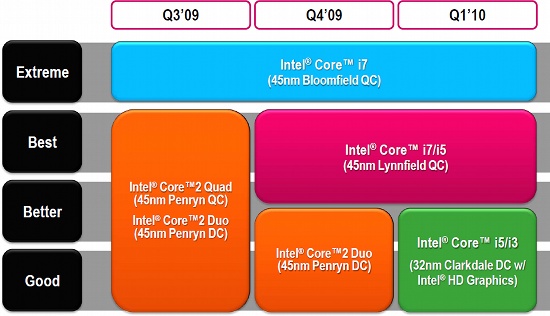
The result: more transistors in a smaller area and hopefully also bring performance gains. Last but not least, there is also a 9-cell battery that should provide 15 inches of mobility. You will find more detailed information in these articles. There were five chips available for our test.
Depending on the specified cores and speed, it is believed that the higher the result achieved, the faster the rendering and the higher the rating in a single task. This ratio is even supported in the 32-bit test. Supreme Commander - Forged Union.
The dual-core Clarkdale hits a different target. With this processor, Intel wants to strengthen its position in the middle and lower market segments, replacing the obsolete LGA775 models with a new product. Obviously, there is a real practical meaning to this action. Firstly, Core 2 Quad and Core 2 Duo are experiencing quite serious pressure from very successful AMD processors series Phenom II and Athlon II, and the possibility of changing them to more productive solutions is by no means superfluous. Secondly, the appearance of new names in itself should revive sales that have traditionally withered after Christmas, and besides, it should also spur sales of logic sets and motherboards, since when switching from Core 2 processors to new models, they will also have to be replaced.
However, it should be noted that in the mid-price segment, Intel feels confident even without new processors - this is evidenced by their launch, obviously specially postponed to the post-New Year days, so as not to interrupt Christmas sales of the usual Core 2 and Core i5-7xx; if there were any difficulties with sales of these models, it is obvious that Intel would try to release new processors no later than mid-December. In this regard, one can even suspect some intrigue: will the new models really be significantly superior to previous processors from the point of view of consumers, or is the release of Clarkdale a purely formal event, following the “tick-tock” strategy, testing the 32-nm process technology and spurring sales of new ones? logic sets? This is what we have to find out in today’s article.
Evolution of the LGA1156 platform
Coming to replace processors of the Core 2 family, Clarkdale processors consign the entire LGA775 platform to the dustbin of history. Being representatives of the Nehalem microarchitecture, Clarkdale does not use processor bus FSB, as well as Bloomfield and Lynnfield, have a built-in northbridge. At the same time, Intel did not introduce a new type of processor socket for Clarkdale, but made it compatible with the LGA1156 platform, which, obviously, is now becoming an almost universal choice. Accordingly, Clarkdale, like the previously released LGA1156 Lynnfiled processors, have the same set of functional blocks (computational cores, L3 cache, memory controller, PCI Express controller), and use the DMI bus to communicate with the south bridge of the chipset.
In fact, with the release of Clarkdale, Intel is completing the evolution of its platforms. As a result of this evolution, a set system logic has finally lost its traditional role - the north bridge is now part of the processor, and only one chip remains from the chipset, which is responsible for implementing the interfaces necessary for connecting external equipment - the south bridge. Thus, any modern system now consists not of three, but of two main chips.
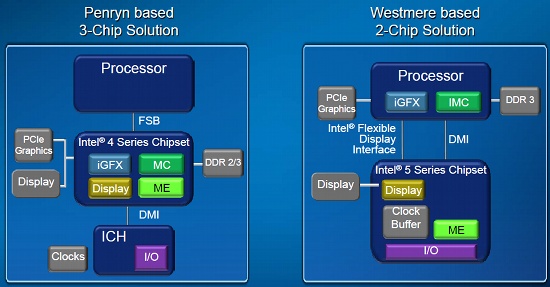
The integrated benchmark test was used for comparison, as its report also indicates the average frame rate at the end. The single chip results remained very close in all tests performed. As before, most of the gaming performance in the future will also be assigned to graphics cards.
Which processor should you choose?
The test system consumes about 30 W more from the mains under load. We're really excited about these chips, primarily because most of them have the ability to automatically overclock themselves to improve performance or reduce their clock speed to save time battery life.
Bringing Clarkdale into line with new principles for building platforms, Intel developers had to take another important step. The fact is that since Clarkdale is targeting the middle and lower market segments, one of the platform options based on it should include an integrated graphics core. Previously, graphics cores were built into the northbridge of the logic set, but now it, as an independent functional unit, has been abolished. As a result, the graphics core, following the memory controller and PCI Express bus controller, also migrated to the processor - and as a result, Clarkdale became one of the first processors for desktop computers, including not only computing units, but also a GPU.
It should be noted that the presence of a graphics core in Clarkdale does not at all mean that it is necessary to use it in any system. The processor also retains the PCI Express x16 graphics bus controller, which means Clarkdale-based systems can also be equipped with external graphics cards. In this case, the built-in GPU is simply disabled. Systems built on mobile analogues of Clarkdale - Arrandale - will also be able to offer some options for interaction between graphics integrated into the processor and an external video card, for example, the ability to switch between the internal and external graphics core without rebooting the system. However, on desktop platforms this function will not be implemented.
To use the graphics core built into the processor in conjunction with Clarkdale, it is necessary to use special chipsets called Intel H55 Express, H57 Express and Q57 Express. Their main difference from the existing LGA1156 chipset Intel P55 Express is the presence of a special digital interface Intel FDI (Flexible Display Interface), designed to transmit a video signal from the processor through the LGA1156 connector outward to the video outputs of the motherboard. However, the implementation of this scheme is extremely simple: the FDI bus uses the DisplayPort protocol, and chipsets that support integrated graphics contain only a small controller in their south bridge that provides routing and digital-to-analog conversion of the video signal.
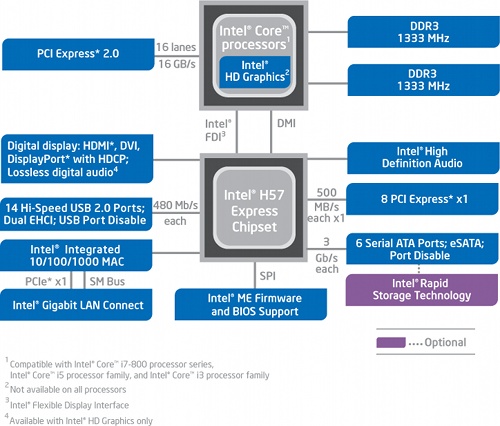
As a result, various LGA1156 processors and motherboards, despite the very noticeable differences between them, they turn out to be compatible with each other. Clarkdale processors can work with external graphics card in any LGA1156 boards, both based on the old Intel P55 and those based on the new ones Intel chipsets H55, H57 and Q57. But to use the built-in Clarkdale GPU, only boards with Intel based H55, H57 and Q57, which support FDI and have "monitor" outputs on the rear panel. By the way, Lynnfield processors already on the market are also compatible with the new chipsets, but since they do not contain an integrated graphics core, an external video card will be required.

All smart stuff, we think you'll agree, and hopefully this will give you a rough idea of how these newfangled chips compare to each other and what kind of performance you can expect. As always, we plan to give you full, hands-on reviews of the laptops that will feature these chips in the very near future, so keep your eyes firmly on that front.
There is a lot of attention. When quad-core chips move to the 32nm process, it will be part of this step. These are all dual-core chips for desktops and laptops. Most of them have hyperthreads, but none have turbo. Software it is written so that workloads are divided into threads. While operating systems are getting smarter about this, hyperthreading makes the operating system think it's twice as big of course. What about the turbopump? If a machine is running a quad-core processor but only needs one core, three cores will be disabled to save power or transfer some of their power to one working core.
In addition to the presence or absence of means to use the graphics built into the processor, there are other differences between LGA1156 chipsets. Thus, the Intel P55, which does not support the FDI bus, is the only chipset that allows you to use a pair of video cards in the PCI Express 8x + 8x scheme. Aimed at entry-level systems, the Intel H55 does not support RAID, and also has a reduced number of USB 2.0 ports from 14 to 12 and a reduced number of PCI Express lanes for peripherals. Intended for corporate use, the Q57 allows the use of remote maintenance technology for Intel AMT systems. Intel H57 is the most feature-rich option, while supporting the GPU built into the processor.
Clarkdale processor inside
Expanding the scope of applicability of the LGA1156 platform, for which until now there were only quad-core solutions with a relatively high cost, Clarkdale was conceived by the developers as an inexpensive dual-core processor. However, due to the built-in graphics core, its complexity may well be comparable to quad-core Lynnfield processors. This means that, despite the use of new 32-nm technology, Clarkdale's production costs had every chance of being so high that promoting these processors in the lower sectors of the market would be a completely pointless undertaking for the manufacturer.
Therefore, in order to reduce the cost of the new processor, Intel engineers proposed an original design that involves using not a single monolithic semiconductor chip with a relatively large area, but two relatively small chips combined into a single product on one board inside the processor package. The division is made on a functional basis: the first small crystal with an area of approximately 79 square meters. mm is directly a dual-core processor, the second one is 38 sq. mm more - GPU. However, even with such a fairly natural distribution of roles, there are interesting nuances in the Clarkdale design. The fact is that in this implementation the processor chip contains only two computing cores and a third-level cache. Still the elements north bridge, including the memory controller and PCI Express bus controller, ended up on the GPU chip.

Sleeping cores are automatically activated when necessary. Most of these chips have hyperthreading, and they all have a turbobus. These chips provide "unlockable capabilities" that allow enthusiasts to more easily adjust clock speeds, speeds, and bus voltages. So what do you need? With so many processor options, it can be difficult to determine which processor suits your or your company's needs.
Firstly, it all depends on what applications you use and what kind of work you do. This will make them happy from a budget and performance standpoint,” Olds added. 32nm dual-core or 45nm quad-core? These processors work a little differently and can spin around if you go too deep.
The result is a rather interesting picture: despite the fact that Intel talks about merging the processor and the northbridge, if you dig deeper, LGA1156 systems with Clarkdale processors structurally look almost the same as the platforms of the previous generation. The Northbridge has not gone away, it even exists in the form of a separate semiconductor crystal. It’s just that now this crystal does not have its own case, but is hidden inside the processor package. However, the FSB bus is truly a thing of the past, and a high-speed QPI interface is used for communication between the processor die and the northbridge die, located inside a single processor package.

The actual processor chip is manufactured using new technology with standards of 32 nm. There are no special innovations in the technological process; the output is transistors that use a dielectric with a high dielectric constant and metal gates, similar to their prototypes used in Intel 45-nm semiconductor devices. However, even a simple reduction in the size of transistors allows you to increase their switching speed, reduce heat generation and gain in the size of the semiconductor crystal, which fully pays for the introduction of a new process and immersion lithographic equipment that has begun to be used at Intel factories. Thus, the area of the Clarkdale processor die is comparable to the area of the Wolfdale-3M die, which is used in the Core 2 Duo E7000 processors, but the 32-nm CPU has a larger amount of cache memory. However, calling Clarkdale a completely 32nm processor would not be entirely fair. The fact is that in the production of the second semiconductor crystal included in its composition, which combines the GPU and the north bridge, Intel uses the old 45-nm process technology.

If you are confused about which processor you should continue with, we have broken down the processors into the significant differences between them. The core can be adopted as a separate processor. Thus, a dual-core processor has two internal processors, a quad-core model has four. The extra cores are useful for multitasking, for example, you can run two applications simultaneously, each with access to its own dedicated processor. The more cores, the more tasks you can perform simultaneously.
Hourly speed is not the only thing that determines how good a processor is, other factors also play an important role and cache size is one of the factors. The larger the cache, the better. Hyperthreading is the process of executing multiple tasks simultaneously. Thus, it is a useful way to reduce complexity when working and working on different tasks at the same time.
Inside the processor chip there are two cores with Nehalem microarchitecture that support Hyper-Threading technology. Thus, despite the fact that Clarkdale is a dual-core processor, the operating system will see 4 cores in it. And it is precisely this fact that allows Intel to position the older representatives of the Clarkale family as a replacement for LGA775 quad-core processors. The volume of third-level cache memory, which is also located in the 32-nm processor chip, is 4 MB. Thus, compared to Lynnfiled, Clarkdale has halved not only the number of cores, but also the size of the L3 cache.
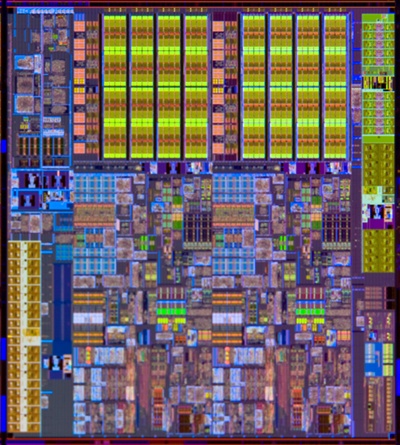
32nm Clarkdale processor core
The main part of the second crystal is occupied by the graphics core, which is the following Intel generation G.M.A. Compared to the GMA X4500, built into the LGA775 chipsets of the Intel G45 family, the new graphics core features an increased number of shader processors from 10 to 12, a slightly increased frequency and the ability to use larger amounts of memory for its needs. However, in terms of overall performance it remains an integrated solution, which means Clarkdale does not claim to be an alternative to discrete video cards.

- Not for gamers or professionals.
- Those who want a balance between performance and price.
Keep in mind that hyperthreading or turbocharging are not features available on all models. Feel free to message me, mad scientist. All of these chips are built on a 32nm architecture, which ensures that more transistors can be etched onto the silicon chips. The twin as well as the quad cores each have 4 threads.
Along with the graphics core, the second crystal contains a dual-channel memory controller that supports DDR3 SDRAM. It should be noted that, unlike the Lynnfield memory controller, the Clarkdale only supports DDR3-1067 and DDR3-1333 memory; there is no possibility of using DDR3-1600 in normal mode, without overclocking the processor. In addition, the actual speed of the memory subsystem in platforms built on Clarkdale will be somewhat lower also because the memory controller and processor are located in physically different semiconductor chips, communication between which is carried out via the internal QPI bus.
Another important one functional unit, located in the semiconductor chip of the north bridge, this is the graphics bus controller. It uses the PCI Express 2.0 protocol and supports 16 lanes, which can be combined into one PCI Express x16 bus, or divided into two PCI Express x8 buses. However, such splitting is only possible when the processor is installed in a motherboard with an Intel P55 chipset.
Clarkdale Species Diversity
Just as Lynnfiled processors were embodied in two processor families Core i7 and Core i5, Clarkdale will exist in three guises at once: Core i5, Core i3 and Pentium. This means not only that the sales price of Clarkdale versions will vary widely, but also that Intel will offer different versions of Clarkdale, differing not only in clock speeds. To differentiate Clarkdale species by family, disabling Hyper-Threading and Turbo Boost technologies and manipulating cache memory sizes will also be used. As a result, taking Lynnfield into account, Intel will now offer five types of processors for the LGA1156 platform, general information about which we have tried to present in a single table.
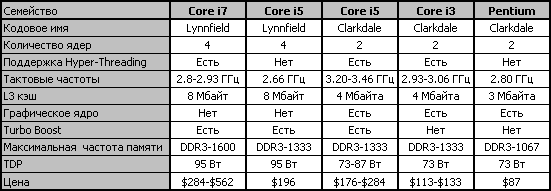
They form the mid-level segment. Since the comparison with four cores and double core will be proven, larger number cores can significantly increase computing speeds. They are designed for high-performance computing applications, web servers, and high-performance business users. It is great for home desktop computers. Budget wise, they may be the most expensive of the lot, but they offer true value for your money.
Choose any of these three lines that suits your budget and computing requirements. All processors have dual-core and four threads, with integrated GPU. The main difference is the migration to a 32nm architecture, which allows for more transistors to be placed on a chip. This line consists of dual-core and quad-core processors with 4 and 8 threads respectively. It can increase the clock frequency and increase it beyond the set frequency when necessary.
Please note that the older Clarkdale from the Core i5 family is targeting approximately the same market niche as the younger Lynnfield. Obviously, Intel rates its new dual-core processors very highly, believing that thanks to high clock speeds and the use of Hyper-Threading technology, they will be able to perform on an equal footing with quad-core processors.
In total, Clarkdale will be available in seven different versions.

The Core i5-600 processors represent the most feature-rich version of Clarkdale. They support both Turbo Boost and Hyper-Threading technology, and their nominal clock speeds exceed those of the quad-core Core i7 even with Turbo Boost technology running. Moreover, in Core series i5 there are two older models at once: Core i5-670, which has a maximum clock frequency of 3.46 GHz, and Core i5-661, the frequency of which is set to 3.33 GHz, but the graphics core is overclocked to 900 MHz - the highest value among the others available options.
Core i3-500 processors do not support Turbo Boost technology, and therefore can seriously lag behind the Core i5 on a single-threaded load, despite the fact that their nominal frequencies are relatively close. However, support for Hyper-Threading is still in place, which means that these processors, like the Core i5-600, can be considered as competitors to inexpensive quad-core processors.
The Pentium has the poorest characteristics. This processor lacks not only Turbo Boost, but also Hyper-Threading technology, and therefore appears in the operating system only as a dual-core CPU. In addition, this inexpensive processor It is equipped with a slow-clocked graphics core and also does not support DDR3-1333 memory. In other words, a typical budget option, in which all possible “goodies” are blocked. In addition, the third level cache in the Pentium processor is reduced to 3 MB.
It should be noted that in Clarkdale processors Intel did not make Turbo Boost technology as aggressive as in Lynnfield. In all new Core i5-600, where this technology is present, the processor frequency can increase by one step when loading on two cores and by two steps when running a single-threaded load. This means that the maximum possible frequency increase for Clarkdale is only 266 MHz. At the same time, Lynnfied processors can increase their frequency by 4-5 steps, that is, the frequency increase can reach 667 MHz. This fact makes some adjustments to the correspondence between the frequencies of dual-core and quad-core LGA1156 processors: under partial load, the difference in the operating speed of Lynnfiled and Clarkdale processors may decrease. The operating frequencies of Core i7 and Core i5 processors supporting Turbo Boost LGA1156 under different load conditions are shown in the following table.
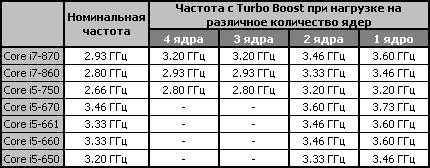
Let's take performance first. A million views per month is such a low volume that you could use almost any old chip to handle it. You can run tests on your laptop or desktop to see if this chip can handle your peak workloads. Remember to populate your database with several months of data first.
Then you are concerned about reliability, meaning you work for months and months. The most important thing is the presence of disk storage, which most likely fails. You want to ensure that you don't lose any data if the drive fails. Then you want to prepare for disaster so that you still have your data if the entire data center goes down. If you don't want to lose any data at all, you need to copy your database to another site. If losing half a day or so isn't a big deal, just plan backup over the network.
If in LGA775 systems dual-core processors were faster than quad-core processors in a number of tasks due to their higher clock speed, then in LGA1156 such a picture will be observed much less frequently. Thanks to Turbo Boost, quad-core Lynnfields automatically overclock when the load intensity decreases and only two or one core is used, bringing their frequency very close to the operating frequency of dual-core CPUs. So the same cost of the Core i5-670 and Core i7-860 should not be misleading; it is justified not so much by the computing performance of the older Clarkdale, but by the fact that, thanks to the built-in graphics core, they provide greater capabilities.
Weak link: Clarkdale memory controller
The two-chip structure of the Clarkdale processor looks interesting and quite reasonable. It is clear that by dividing the functions of a highly integrated processor into two semiconductor devices connected in one package, Intel engineers received a fairly inexpensive product that can be launched not only into the middle market segment, but also as a budget offer. However, it is obvious that such a reduction in cost may result in the emergence of shortcomings in technical specifications. In the case of Clarkdale, a serious concern is the fact that the integrated memory controller has become less integrated, which may affect the speed of this processor with memory.
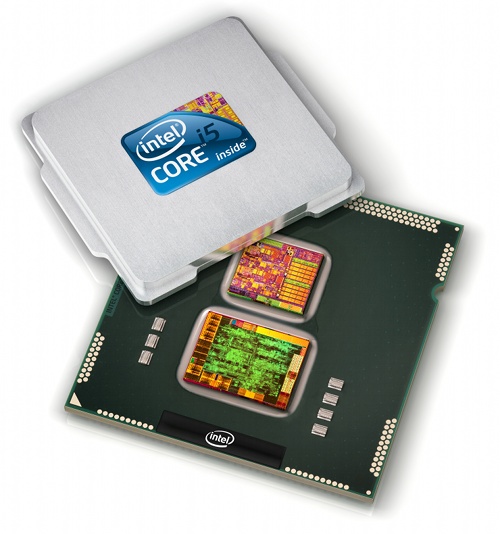
If your host is going down, either because the power supply is blowing, LAN card, memory, CPU fans, or other components fail, you must have some kind of failover mechanism. This is typically achieved by running in a cluster, where two or more systems are connected to the same storage. Instead, use the money to buy a second standby server. If they are professional, they will have that support down to the science, including backups off-site, and fast recovery after server failure.
Although the memory controller is located in the processor case, this does not bring it closer to the processor cores. In Clarkdale, it, together with the GPU, is placed in a separate semiconductor crystal. This, of course, is good from the point of view of increasing the performance of integrated graphics, which have a fast memory access path, but at the same time the memory controller moves away from the processing cores. As a result, processor cores operate with memory not directly, but through an intermediate QPI bus, which connects the CPU and GPU crystals inside the Clarkdale package.
What does this mean from a practical point of view? For initial testing, we decided to use synthetic tests to compare the speed of the LGA1156 memory subsystem of Core i5 processors from the Lynnfield and Clarkdale families. In the first processor, the memory controller is located on the same semiconductor chip with the computing cores, so no intermediate buses are needed to work with memory. The second processor has a “remote” memory controller, the work of the computing cores with which is built along a long chain of core - QPI controller - QPI bus - QPI controller - memory controller. During the test, we ran both processors at the same frequency of 2.8 GHz. The memory in both cases operated in DDR3-1333 SDRAM mode with timings of 9-9-9-27.
First of all, the Cachemem test from the Everest Ultimate 5.30 diagnostic utility was used.

Lynnfield 2.8 GHz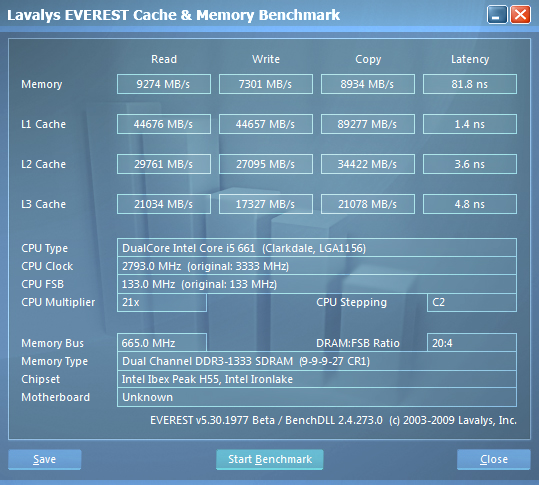
Clarkdale 2.8 GHz
The results are, to put it mildly, very sad. In practical bandwidth memory subsystem in read and write operations Clarkdale loses to Lynnfeld by about 25%. From the point of view of latency for the new product, everything looks even worse - the gap reaches 45%. Unfortunately, reducing the cost of a processor architecture by dividing key functional blocks across two different semiconductor chips is very expensive.
This unpleasant conclusion is confirmed by another utility that measures practical parameters memory subsystems, MaxxMem. And this is despite the fact that for comparison with Clarkdale we chose the youngest from Lynnfield, Core i5-750, which has the slowest memory controller, operating at 2.13 rather than 2.4 GHz.
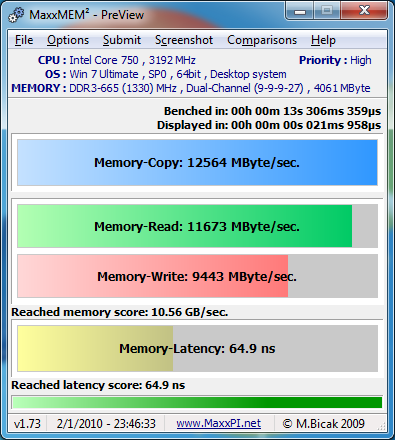
Lynnfield 2.8 GHz
Clarkdale 2.8 GHz
As long as the system options they offer have sufficient performance, then you should be able to sleep at night. Spending extra dollars on powerful chips doesn't give you any of the skill you're looking for. In the following article, we present all the laptops that are currently available on the market and give a rough breakdown of the power consumption and performance of the different architectures.
One of the most important innovations is the improved 14nm process technology, which has been particularly optimized for the requirements of low-power architectures. The innovative manufacturing process provides significant efficiency gains, but also introduces various technical difficulties that have led to delays in launch and delivery issues in the market. Together with slightly increased clock speeds, which in turn are due to a more refined manufacturing process, overall performance can be significantly higher depending on the model.
It must be said that the Clarkdale pseudo-integrated memory controller turned out to be so slow that its speed is very close to the speed of memory controllers of LGA775 systems that use the FSB bus for communication between the CPU and the memory controller. Look, for example, at the Cachemem result we shot on an LGA775 system with DDR3-1333 SDRAM with timings of 9-9-9-27, built on the Intel P45 chipset and a Core 2 Quad Q9550 processor.
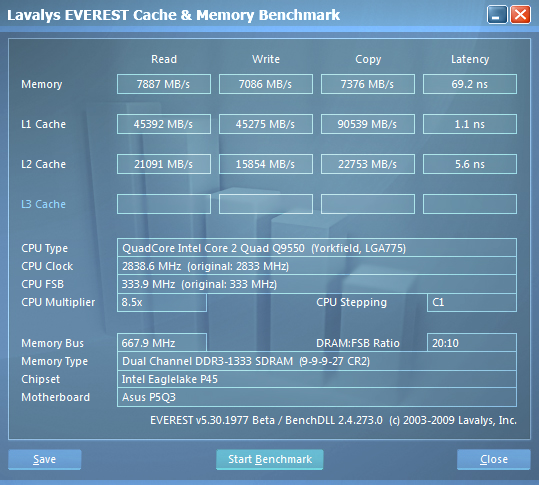
Yorkfield 2.83 GHz
The memory subsystem in the LGA775 platform exhibits even lower latency than the memory in a Clarkdale-based system! So, the separation of the memory controller and processor cores across two different crystals, even if located inside a single package, led to an extremely negative decrease in the speed of the memory subsystem, which eventually dropped to the level observed in systems with an outdated structure (with the north bridge placed in a separate chip ).
The described problems are aggravated by the fact that the Clarkdale memory controller reacts somewhat strangely to attempts to use low timings. On none of the three LGA1156 motherboards from ASUS, Gigabyte and Intel at our disposal, based on the Intel P55 and H55 chipsets, we were unable to set the CAS Latency to 7 cycles. Selecting the appropriate option in BIOS Setup in reality did not lead to the expected effect; in fact, the system worked with a CAS Latency of 8 or 9. I would like to hope that this is not a global limitation of the Clarkdale memory controller, but a manifestation of local “childhood diseases” which will be corrected with the release of new motherboard firmware.
The only consolation in light of the current picture is that the Clarkdale processors were not deprived of third-level cache memory. And although its volume has been halved compared to Lynnfield, it is located in the same chip along with the computing cores. Therefore, if we return to the results of the Cachemem test, we will notice that it works no slower than in Lynnfield, while demonstrating even more high speed records.
Something new: cryptography support
Improvements to the interface as well as larger caches ensure that increased shader power is also reflected in higher frames. The new processors are based on the existing naming scheme, but the 4-digit model name now starts with 3. Depending on the model, you should choose power consumption or performance. Only minor optimizations have been made to the processor core architecture.
We have summarized Additional information in various special articles. However, electricity consumption is also significantly lower. However, thanks to special high-density libraries, the manufacturer has significantly increased the packaging density and combined a number of innovations with almost the same chip area.
Clarkdale CPU Compute Cores vs. Compute Cores Lynnfield cores the developers made virtually no microarchitectural changes. Actually, this is the essence of the “Tick-Tock” concept: if the technical process is improved, then the microarchitecture remains untouched. But, nevertheless, Intel could not resist and added one small but important detail to Clarkdale. This processor now supports several new instructions - the AESNI set. This command set includes six new commands that speed up the AES cryptographic algorithm, one of the most common block cipher algorithms used by a wide variety of software.
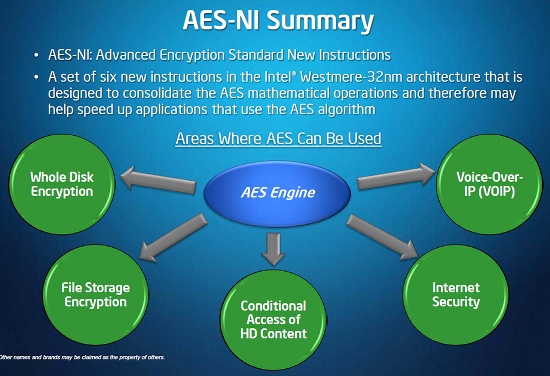
At the same time, you need to keep one thing in mind: AESNI support is not activated in all Clarkdale processors, but only in those modifications that belong to the “older” Core i5-600 series. Processors same Core i3 and Pentium hardware support cryptographic algorithms are currently deprived. This fact allows us to evaluate using real examples how much the encryption speed increases on processors that support AESNI.
For example, to get a first look at AESNI, we used the Sandra utility, which has a cryptographic test, and looked at the results obtained on an LGA1156 system with Core i3 and Core i5 processors, the clock speed of which was set to the same value - 3. 06 GHz.
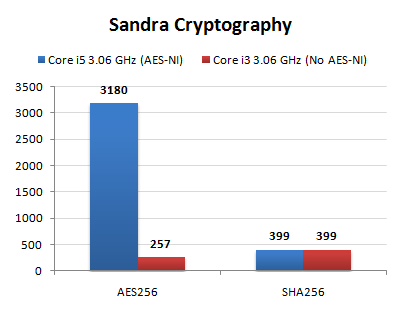
Energy efficiency improvements are still significantly greater. With adaptive voltage handling and adaptive voltage and frequency scaling, the processor can always operate at the optimal supply voltage, which in turn reduces power requirements.
This isn't just down to the dusty 28nm process. However, the most important is the fastest main memory. However, compared to its predecessor, the new chip represents only a slight evolution. Several changes have also been made to the graphics unit.
As you can see, a processor with AESNI support demonstrates encryption performance that is an order of magnitude higher than its counterpart that does not have this support. But, as is easy to see, this effect is observed only when using AES encryption. Another cryptographic test, measuring the hashing speed using the SHA256 algorithm, is executed on both processors at the same speed, which is completely logical, since the instructions included in the AESNI set are utilitarian and can only be used when implementing the AES algorithm.
The situation with the implementation of the AESNI command set is fundamentally different from the difficulty with which the penetration into real support programs for each successive SSE extension usually occurs. Here the picture is the opposite; support for new commands can be found not only in specially optimized synthetic tests. Due to the relevance of the new AESNI instruction set, many popular application developers have already implemented support for it. For example, it is already available in some archivers that allow you to encrypt information along with compression. As an example, this Intel programs recommends WinZIP, version 14 of which uses AESNI, but we decided to check support for the new instructions in another freely available archiver, 7-zip 9.10.
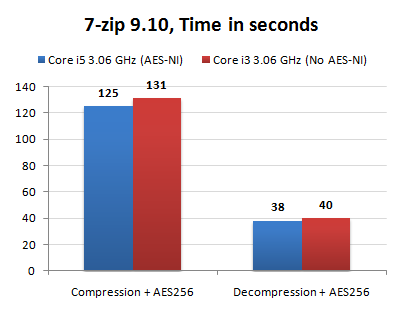
There is acceleration, but it is not as impressive as we saw in the synthetic test. That's right - against the background of the work of other algorithms that perform the actual compression, the gains brought by the advent of fast encryption are somewhat lost. However, its existence, of course, cannot be denied.
Another good news is that AESNI support is available even in the operating room itself. Windows system 7. All programs that use standard functions included in this operating system Cryptography API: Next Generation (CNG) is ready to get increased performance on Clarkdale processors supporting the new instruction set, without any rework. As an example, here is a fairly old test PCMark Vantage, the Communication script from which calls CNG functions to simulate the encryption and decryption processes.

For the first time, the bulldozer architecture familiar from desktops and servers is also used in laptops, but here in an additional optimized version. Similar changes were made to the graphics block. Overall, this leads to a significant increase in performance, which is achieved even in the case of specialized accelerators of the lower middle class.
At the same speed, power was increased by about 5% and there was also a turbo mod on board. Dual-core and single-core processors are available in both series. In the current market of the computer industry, we find several processors of different brands. To briefly explain, the higher the number, the better your processor. Nowadays there are several processors with higher hierarchy and smaller ones that are the most affordable. But when it comes to choosing, we may not know which is best. To do this we need to know the clock speeds that each one brings.
As a result, we see that, despite the lack of explicit support for AESNI in PCMark Vantage, its performance when working in a system with a processor that offers support for this instruction set increases significantly.
Description of test systems
For testing various types Clarkdale we took one copy of each variety of this dual-core processor:
Core i5-661 with nominal clock frequency 3.33 GHz and support for Hyper-Threading and Turbo Boost technologies, thanks to which the frequency of this processor can increase to 3.46 or 3.6 GHz under different load conditions.
Core i3-540 with a nominal frequency of 3.06 GHz and support for Hyper-Threading technology. Turbo Boost is not supported by this processor. Core i3 also lacks support for AESNI commands.
Pentium G6950, whose nominal frequency is set to 2.8 GHz. This processor belongs to the lower level offerings, and therefore it not only lacks support for Hyper-Threading and Turbo Boost technologies, but also has a third-level cache, the size of which is reduced to 3 MB. Note that in addition to all the disadvantages, this processor does not support either virtualization or SSE4 instruction sets.
For comparison with these processors, we took several typical and current representatives of dual-core, triple-core and quad-core processors for LGA1156, LGA775 and Socket AM3 systems, which are common offers and can, from a price point of view, act as competitors for Core i5, Core i3 and Pentium G-series.
A complete list of components used in the tests is provided below.
Processors:
AMD Phenom II X4 965 (Deneb, 3.4 GHz, 4 x 512 KB L2, 6 MB L3);
AMD Phenom II X4 925 (Deneb, 2.8 GHz, 4 x 512 KB L2, 6 MB L3);
AMD Athlon II X4 630 (Propus, 2.8 GHz, 4 x 512 KB L2);
AMD Athlon II X3 435 (Rana, 2.9 GHz, 3 x 512 KB L2);
AMD Phenom II X2 550 (Callisto, 3.1 GHz, 2 x 512 KB L2, 6 MB L3);
Intel Core 2 Quad Q9550 (Yorkfield, 2.83 GHz, 1333 MHz FSB, 2 x 6 MB L2);
Intel Core 2 Quad Q9400 (Yorkfield, 2.66 GHz, 1333 MHz FSB, 2 x 3 MB L2);
Intel Core 2 Quad Q8400 (Yorkfield, 2.66 GHz, 1333 MHz FSB, 2 x 2 MB L2);
Intel Core 2 Duo E8500 (Wolfdale, 3.16 GHz, 1333 MHz FSB, 6 MB L2);
Intel Core 2 Duo E7600 (Wolfdale-3M, 3.06 GHz, 1067 MHz FSB, 3 MB L2);
Intel Pentium E6500 (Wolfdale-2M, 2.93 GHz, 1067 MHz FSB, 2 MB L2);
Intel Core i7-860 (Lynnfield, 2.8 GHz, 4 x 256 KB L2, 8 MB L3);
Intel Core i5-750 (Lynnfield, 2.66 GHz, 4 x 256 KB L2, 8 MB L3);
Intel Core i5-661 (Clarkdale, 3.33 GHz, 2 x 256 KB L2, 4 MB L3);
Intel Core i3-540 (Clarkdale, 3.06 GHz, 2 x 256 KB L2, 4 MB L3);
Intel Pentium G6950 (Clarkdale, 2.8 GHz, 2 x 256 KB L2, 3 MB L3).
Motherboards:
ASUS P5Q3 (LGA775, Intel P45, DDR3 SDRAM);
ASUS P7P55D Premium (LGA1156, Intel P55 Express);
Gigabyte MA790FXT-UD5P (Socket AM3, AMD 790FX + SB750, DDR3 SDRAM).
Memory:
2 x 2 GB, DDR3-1600 SDRAM, 8-8-8-24 (Kingston KHX1600C8D3K2/4GX);
2 x 2 GB, DDR3-1333 SDRAM, 7-7-7-20 (Mushkin 996601).
Graphics card: ATI Radeon HD 5870.
Hard drive: Western Digital VelociRaptor WD3000HLFS.
Power supply: Tagan TG880-U33II (880 W).
Operating system: Microsoft Windows 7 Ultimate x64.
Drivers:
Intel Chipset Driver 9.1.1.1020;
ATI Catalyst 9.12 Display Driver.
As you can see from the list of equipment participating in the tests, we did not use motherboards capable of using the graphics adapter integrated into Clarkdale processors. In this study, we will bypass the issue of its performance. But in the very near future, a separate material will be published on the site, entirely devoted to a comparison of the graphics core built into Clarkdale and the integrated logic sets for the LGA775 and Socket AM3 platforms.
Performance
Overall Performance
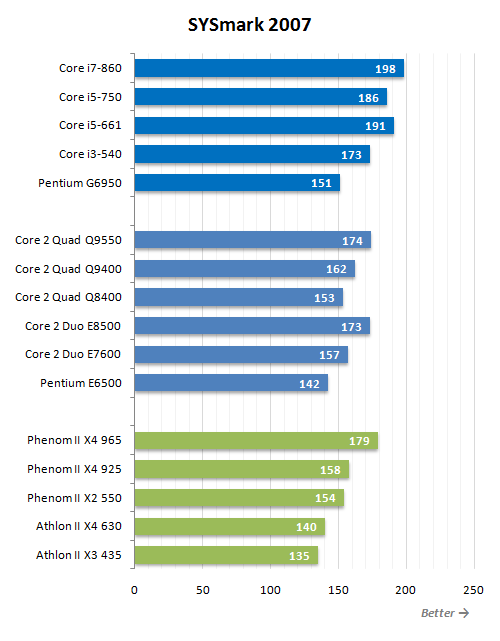
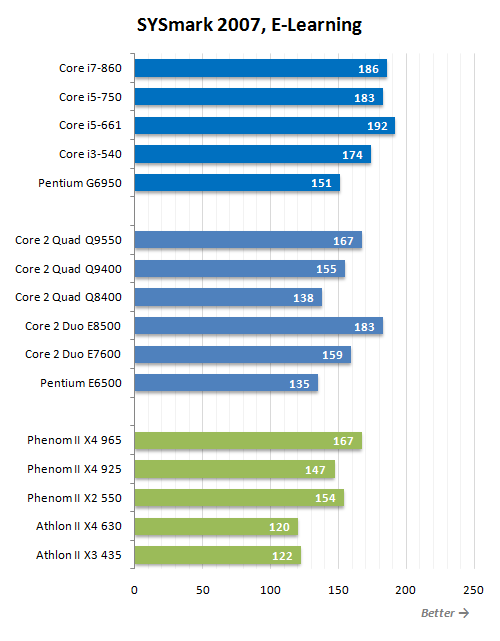
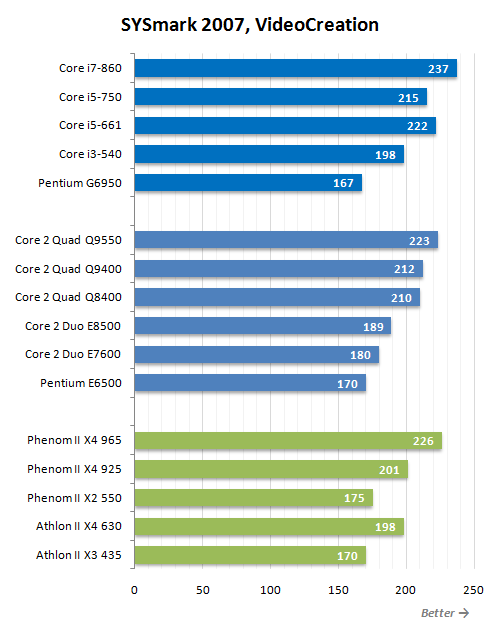


In general, after the first acquaintance, the new Clarkdale processors leave a fairly positive impression. It is based, first of all, on the fact that although the new processors are formally dual-core, thanks to the support of Hyper-Threading technology they work almost like quad-core ones. The older Clarkdale model in our test, Core i5-661, looks especially impressive in this regard. In almost all test scenarios, it not only shows higher results than the older representatives of the Core 2 Quad and Phenom II X4 series, but is also ahead of the younger Lynnfiled modification, Core i5-750. Obviously, a high clock speed and two cores with support for Hyper-Threading turn out to be a very powerful cocktail.
The performance of the Core i3-540 also looks good. In all scenarios except video creation and processing, it also outperforms the quad-core Core 2 Quad and Phenom II X4 processors and is definitely faster than any dual- or triple-core CPU available on the market.
Unfortunately, the brilliant performance of the new Core i5 and Core i3 does not push the Pentium G6950 to similar feats. This is not surprising; this processor is deprived of one of Clarkdale’s strongest trump cards - support for Hyper-Threading technology. As a result, its performance is at the level of inexpensive dual-core Core 2 Duo. In other words, if we base our conclusions on the results of SYSmark 2007, then the Pentium G6950 turns out to be a completely complete replacement for the old one Pentium E-series, however, unlike other Clarkdales, it cannot provide any revolutionary increase in performance.
Gaming Performance
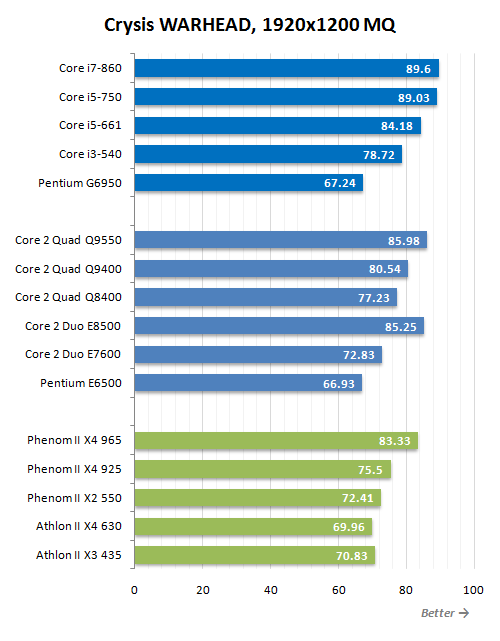
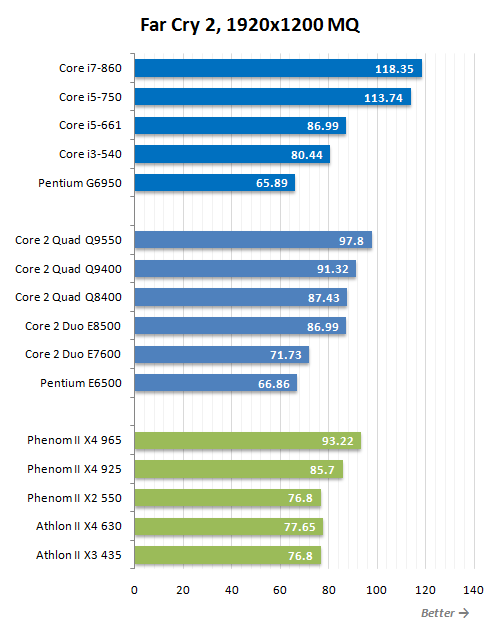
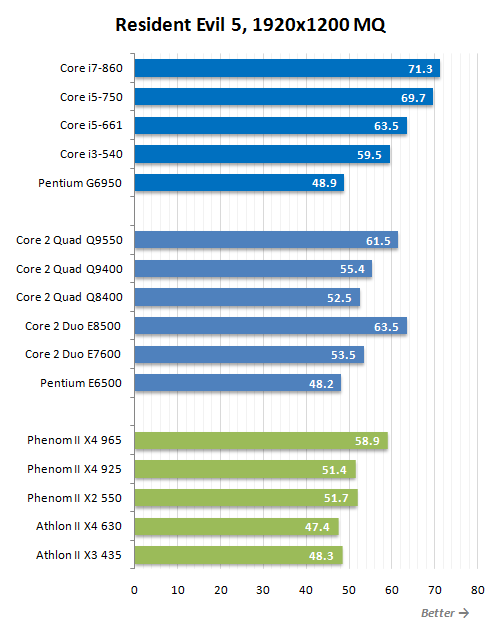

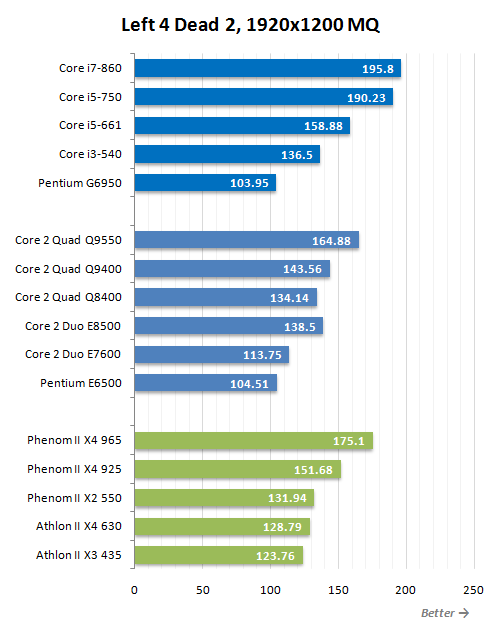
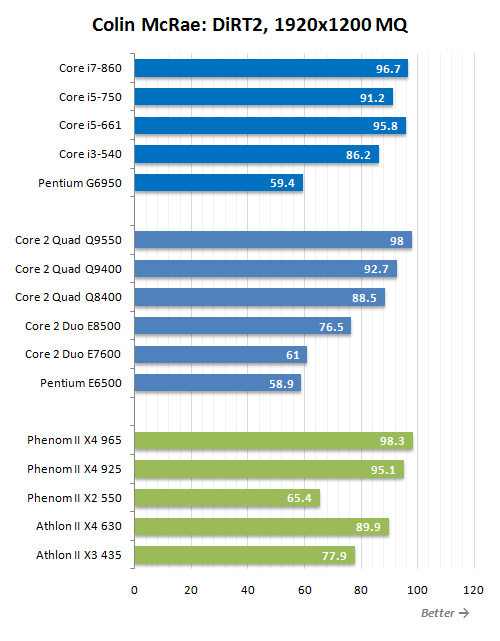
The picture observed in games is somewhat different from what we saw in SYSmark 2007, since generations of gaming applications change much faster than versions of commonly used software packages. As a result, support for new technologies is coming to games faster, and most modern 3D games are already quite capable of efficiently using the resources provided multi-core processors. That is why in games quad-core Lynnfield processors are ahead of Clarkdale, which, moreover, have a reduced L3 cache and a relatively slow memory controller. However, this does not at all prevent dual-core new products from not only being inferior to solutions for the LGA775 and Socket AM3 platforms, but also quite often outperforming them.
In general, dual-core Core i5 and Core i3 seem to be a good option for use as a mid-level gaming platform. The Core i5-600 series processors allow you to easily create configurations that demonstrate performance at the level of systems with quad-core Core 2 Quad and Phenom II X4 processors, which in terms of their performance will be inferior only to much more expensive systems with older Core i7 processors.
The Core i3 series is also capable of shining in its price category: in our tests, this CPU showed performance at the level of its older representatives model range Core 2 Duo, which makes it a full-fledged alternative to the younger Phenom II X4 and Core 2 Quad.
The only thing that is somewhat disappointing is, perhaps, the results of the Pentium G6950. Often it performs even worse than the LGA775 processor of the Pentium E6500. It seems that Intel engineers went a little overboard with cutting down the capabilities of this cheap processor.
Audio processing
This section presents two tests: converting a set of audio files into mp3 format in iTunes 9 and final mixing of a musical composition in the popular software synthesizer Acoustica Mixcraft.
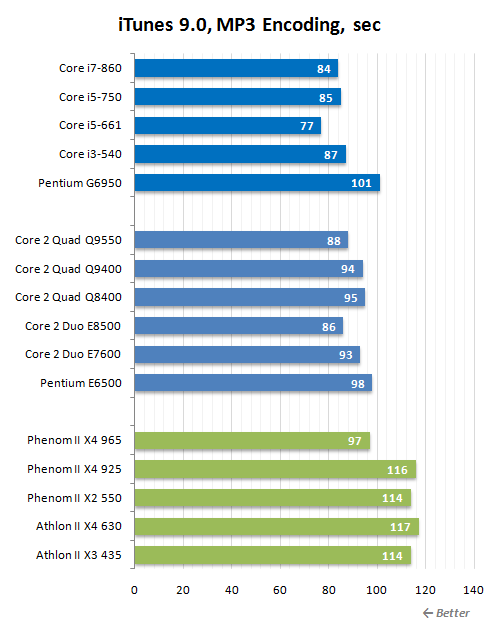

New, already the ninth in a row iTunes version continues to be optimized only for dual-core processors. This is precisely the key to their successful performance in this test: the new Core i5-661 and Core i3-540 show almost better performance among all test participants.
As for the results in Acoustica Mixcraft, Clarkdale processors are given an unexpected rebuff by AMD products, which can offer better processing speeds in their respective price categories. However, if we compare LGA1156 and LGA775 processors with each other, the situation remains familiar: Core i5 can be considered as a full-fledged replacement for Core 2 Quad, and Core i3 can offer better performance than Core 2 Duo.
Working with video
To test the speed of processors when working with video content, we used three tests: transcoding HD MPEG-2 video into H.264 format using the x264 codec, converting HD MPEG-2 video for viewing on Apple iPhone using Cyberlink MediaShow 5 and exporting the edited clip to H.264 Blu-ray format in Adobe video editor Premiere Pro CS4.

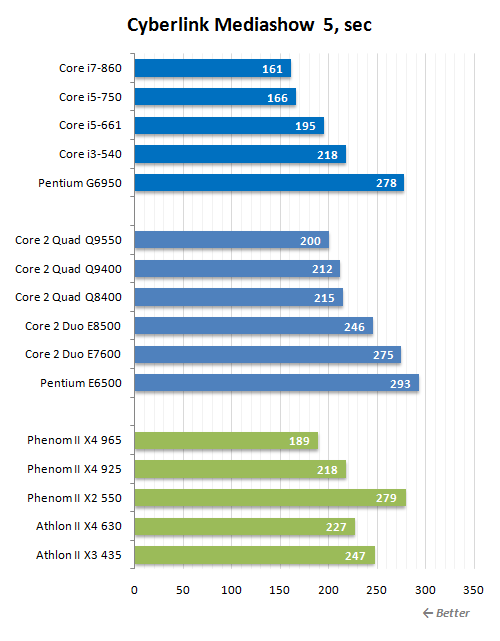
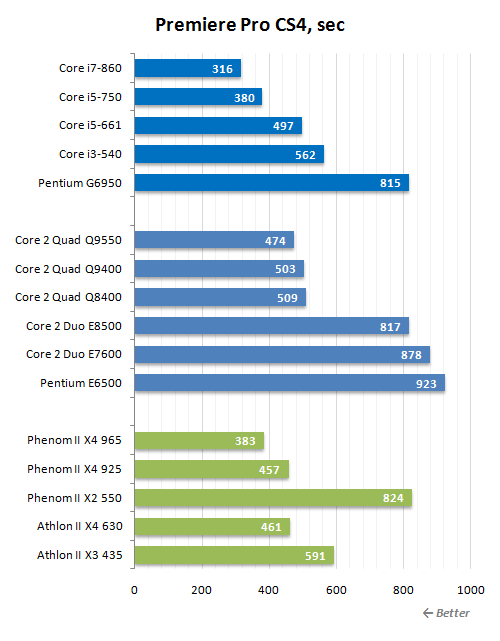
Three different programs for creating and processing video content are similar in one thing: they are all well optimized for multithreading. Therefore, the more cores, and, if possible, real ones (and not virtual ones generated by Hyper-Threading technology), the better. Therefore, in this group of tests, the Core i5 and Core i3 of the Clarkdale family lose to the “real” quad-core Phenom II X4 and Core 2 Quad. However, it is thanks to Hyper-Threading technology that these processors are clearly ahead of not only the dual-core Core 2 Duo and Phenom II X2, but even the triple-core Athlon II X3. The Pentium G6950 processor, which does not support Hyper-Threading technology, although it belongs to the Clarkdale family, performs very poorly in this group of tests.
Final rendering
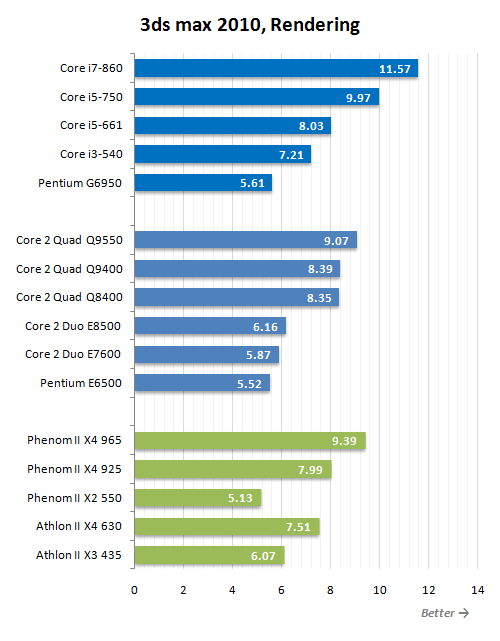
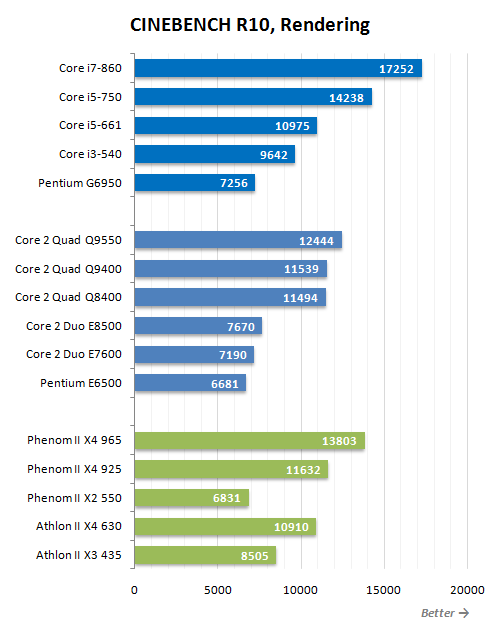
Rendering, like video processing, is a highly parallelizable task. Therefore, in general, exactly the same patterns are observed. Clarkdale's dual-core processors, which support Hyper-Threading technology, are ahead of dual-core LGA775 processors, but behind LGA775 quad-core processors. In other words, it is quite possible to say that Core i5 and Core i3 processors raise the performance of platforms with dual-core processors to a new level. And this level is so high that the Core i5-661 participating in the tests turned out to be able to perform on an equal footing with the younger quad-core processors of its competitor, AMD. However, the positive assessment of the Clarkdale family does not extend to the Pentium G6950. This CPU is only slightly faster than the younger dual-core LGA775 representatives, and therefore, compared to its peers, it looks like an ugly duckling.
Other applications
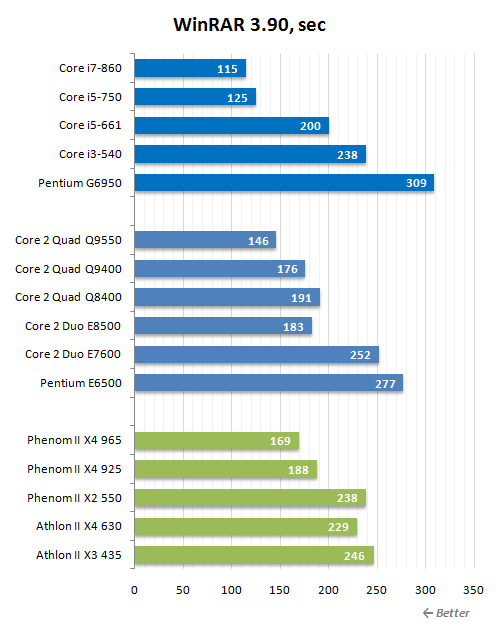
Clarkdale's gap to Lynnfield seems dismal. Here it is - the result of transferring the memory controller to a separate semiconductor crystal. Therefore, seeing that the Core i5-661 was inferior to the Core 2 Duo 2 8500, one should not be surprised. When archiving new Core i5 and Core i3 operate at approximately the same speed as dual-core processors for the LGA775 platform. Accordingly, the Pentium G6950 turns out to be the slowest representative in the archiving speed test.

To test the speed of image processing in Photoshop, this time we abandoned the traditional PSBench and prepared a new test, which is an improved Retouch Artists Photoshop Speed Test, including typical processing of four 10-megapixel images taken with a digital camera. With such a load, the Core i5-661 processor is able to compete with LGA775 and Socket AM3 quad-core processors; Core i3-540 performs at the level of the best dual-core CPUs; and the Pentium G6950 ingloriously loses to the previous generation Intel processors with two cores.
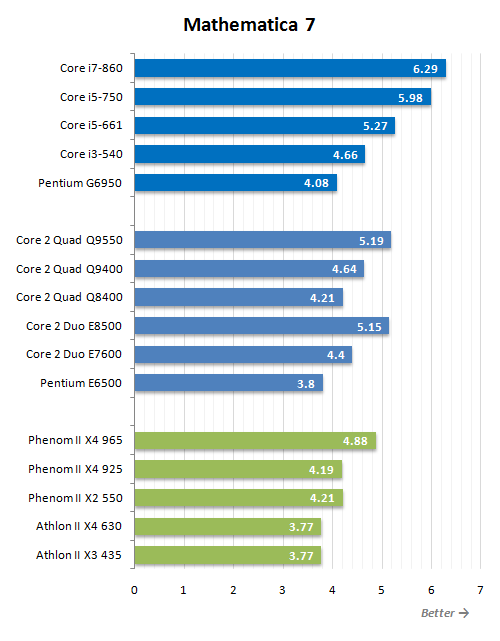
In the mathematical package Mathematica 7, support for multithreading (within one kernel) is not implemented in the best way. Therefore, the standard test ranks processors in a very non-standard way. However, the various Clarkdales perform quite appropriately, raising the performance bar at each price point.

In the distributed computing project Folding@Home new processor The Core i5-661 is not up to par with quad-core CPUs in terms of performance. However, it, like the Core i3-540, is clearly ahead of all other dual-core processors, which is another clear example of the usefulness of Hyper-Threading technology.
Energy consumption
One of the most intriguing characteristics of Clarkdale processors is their heat dissipation. After all, their production partially uses a new 32-nm technological process, the introduction of which, in theory, should affect real energy consumption. On the other hand, the calculated heat dissipation indicated by the manufacturer for new processors is 73 W. And although this is 22 W lower than the calculated heat dissipation of Lynnfiled processors, this value exceeds the calculated thermal dissipation of Core 2 Duo processors - 65 W. Therefore, it is completely unclear how things stand in reality: whether Clarkdale processors can allow you to build an economical system, or whether dual-core processors with Core microarchitecture offer a better performance per watt ratio.
In light of the above, we tested the real energy characteristics of the systems participating in the tests. The following figures represent the total power consumption of the test platforms assembled (without a monitor) “from a wall outlet”. During measurements, the load on the processors was created by the 64-bit version of the LinX 0.6.3 utility. In addition, to correctly assess idle power consumption, we activated all available energy-saving technologies: C1E, Cool"n"Quiet 3.0 and Enhanced Intel SpeedStep.
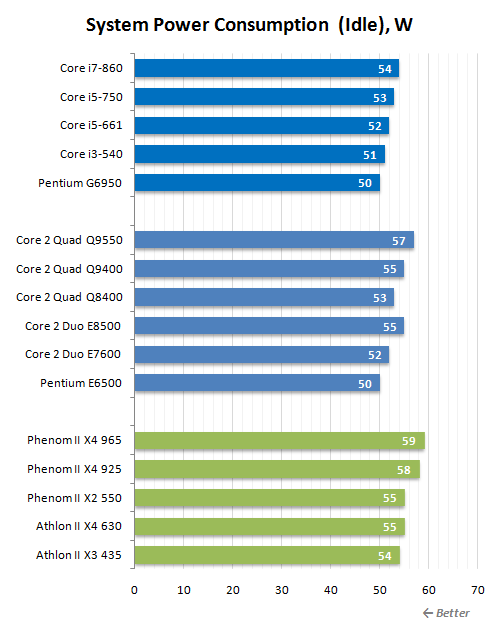
At rest, the consumption indicators of the LGA1156 platform equipped with Clarkdale processors look very good. In this state, it turns out to be even more economical than a platform with LGA775 processors. By the way, note that the total consumption of full-fledged performance platforms at rest is only a little over 50 W. This is a merit not only of modern processors equipped with effective energy-saving technologies, but also of the Radeon HD 5870 video card we use, which in 2D modes is several times more economical than its predecessors.
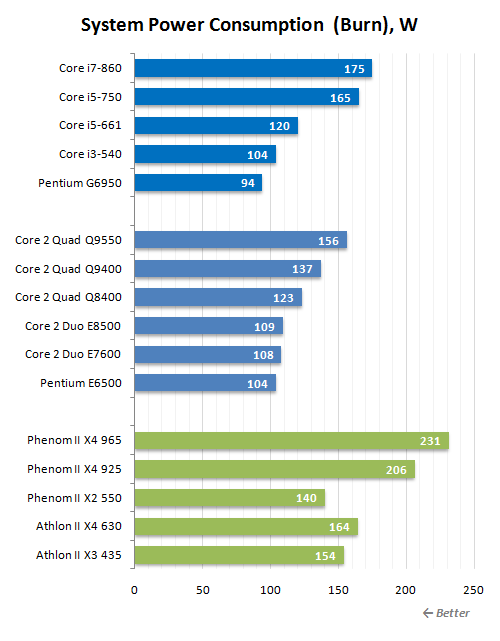
Under load, the situation turns out to be exactly as one would expect based on the official TDP values. Systems with Core i5 and Core i3 processors consume slightly more than configurations based on dual-core LGA775 processors. However, in terms of power consumption, they are not superior to systems with quad-core processors. The Pentium G6950 stands out somewhat from the overall picture, which unexpectedly turned out to be even more economical than the Pentium E6500 for LGA775 systems. In general, we can say that the consumption of new processors correlates well with their performance. Yes, they have become more power-hungry than dual-core processors of the previous generation, but at the same time their performance has also increased significantly.
To obtain a more complete and comprehensive picture, a separate study of the power consumption of the tested processors and motherboards under load, in isolation from other computer components, was carried out. More precisely, the consumption was measured on the 12-volt power line, connected directly to the processor voltage converter on the motherboard, and on the power lines of the motherboard.
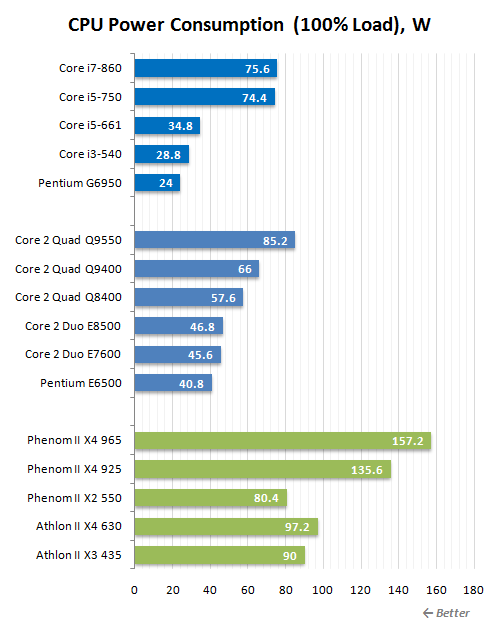
It's amazing how low power consumption the Clarkdale processors achieve. However, the observed picture is easily explained. The fact is that in Clarkdale, only the 32-nm processor chip itself is powered by a dedicated 8-pin 12-volt connector on the motherboard. The second, 45-nm semiconductor crystal takes power through the motherboard. That is why we additionally provide figures for the consumption of motherboards via a 24-pin ATX connector.
![]()
Now everything falls into place. Such low consumption figures through the 8-pin power connector in the LGA1156 system are more than compensated by the high consumption of the motherboard.
The use of a new 32-nm technological process in the production of the processor chip of Clarkdale processors makes them a very interesting object for study from the point of view of overclocking. I would like to hope that the new core will be able to please overclockers with its expanded frequency potential, and its 45-nm addition in the form of a GPU and northbridge will not become an obstacle to its development.
All three Clarkdale processors available in our laboratory took part in overclocking experiments: Core i5-661, Core i3-540 and Pentium G6950. Tests were conducted on a platform based on the motherboard ASUS board P7P55D Premium. For cooling, in all cases a Thermalright MUX-120 cooler (with a traditionally curved base) with an Enermax Magma UCMA12 fan (1500 rpm) was used. System stability under load was checked using the LinX 0.6.3 utility.
Overclocking processors in the LGA1156 version can be done only in one way - by increasing the frequency of the BCLK clock generator. This also applies to Clarkdale, which is overclocked in the same way as overclocking Lynnfield processors. At the same time, the presence of a graphics core in the processor does not complicate overclocking in any way, since it is clocked independently. But the memory operating frequency increases proportionally as BCLK increases, so when overclocking you need to monitor it and, if necessary, adjust the corresponding multiplier.
During overclocking experiments, we did not set ourselves the goal of squeezing the maximum possible frequencies out of processors. Therefore, the supply voltage of the processor core increased by no more than 0.15 V relative to the nominal value. Turbo Boost technology was disabled when the BCLK frequency increased.
As a result, the Core i5-661 processor with a nominal frequency of 3.33 GHz and a nominal voltage of 1.16875 V was overclocked to 4.4 GHz.
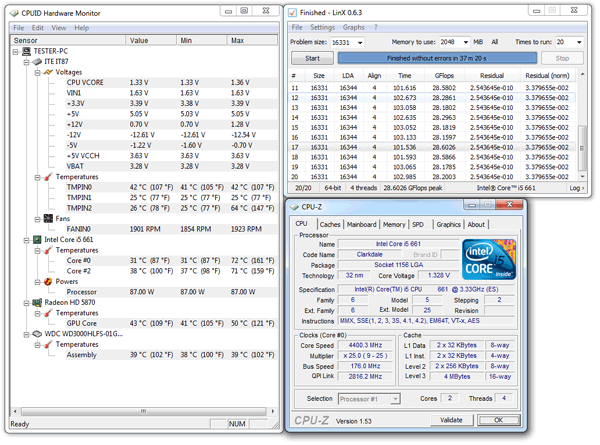
When the supply voltage was increased to 1.328 V, the processor passed stability testing, while its maximum temperature during the test did not exceed 72 degrees according to the sensors built into the computing cores.
The second Clarkdale tested, the Core i3-540, is clocked at 3.06 GHz according to the specifications. The nominal voltage of our copy of this CPU was 1.18125 V.
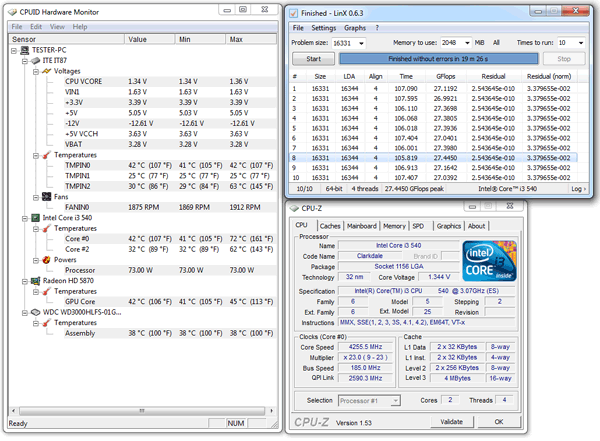
Overclocking it gave slightly worse results. The maximum frequency at which this processor remained capable of stable operation was 4.25 GHz. The supply voltage used for this overclock was 1.344 V. The temperature conditions during stability testing again turned out to be favorable, the processor did not heat up above 72 degrees.
The Pentium G6950 processor is the most problematic option for overclocking. Its standard frequency is 2.8 GHz, which means that setting frequencies above 4.0 GHz will require a very significant increase in the BCLK frequency, which not all motherboards can handle. However, in our case this did not at all prevent us from getting a good result during overclocking.
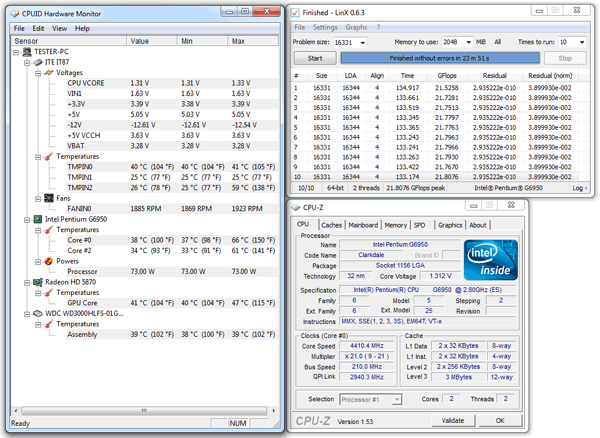
By increasing the supply voltage of the test Pentium G6950 to 1.328 V, we were able to achieve stable operation at a frequency of 4.4 GHz. The BCLK frequency in this case reached 210 MHz, but with an additional increase in the voltage of the north bridge built into the processor from 1.1 V to 1.3 V, no problems arose. It should be noted that the lack of support for Hyper-Threading technology in the Pentium G6950 has a very beneficial effect on its temperature regime: when overclocked, it did not heat up above 66 degrees according to the internal sensor.
As expected, the 32nm technology used to manufacture Clarkdale allows these processors to be overclocked more than Lynnfield. However, 45-nm dual-core Wolfdale processors with Core microarchitecture are sometimes overclocked to higher frequencies when using similar cooling. However, for overclockers looking for higher performance, we recommend choosing Clarkdale, as these processors, featuring the Nehalem/Westmere microarchitecture, boast higher specific performance and will ultimately prove to be a faster option.
Most of the Clarkdale reviews that you can find on the Internet today will probably be full of the most flattering epithets and emotionally convince readers that this is an excellent processor. And, of course, you can’t argue with this, but we have our own “special opinion” about this new product. In our opinion, the Clarkdale is an extremely disappointing processor because it is not at all what we would like to see in a dual-core Nehalem/Westmere microarchitecture. To truly be a superior product that inherited all the strengths of the Nehalem microarchitecture, Clarkdale would have to be based on a monolithic semiconductor chip manufactured in 32nm technology. However, Intel engineers had to compromise with production costs, as a result of which Clarkdale was divided into two semiconductor crystals, one of which is produced using the old production technology. And this has led not only to the fact that Clarkdale processors demonstrate greater heat dissipation than dual-core ones CPU family Core 2 Duo. It’s much worse that some of the important functional blocks, primarily the DDR3 SDRAM controller, became detached from the processor, which led to a serious drop in the speed of memory operations.
However, we will have to wait at least another year and a half to two years for our desires to come true in hardware, until Intel releases dual-core CPUs Generation Sandy Bridge. Therefore, let's turn to the analysis of that “defective” Clarkdale processor that we received today. And despite all its shortcomings, it turned out to be a more than worthy product from a consumer point of view. A slow memory controller did not cause poor performance. The capacious 4 MB L3 L3 cache partly mitigates this drawback, and the other advantages of the Nehalem microarchitecture have not gone away.
As a result, Core i5-600 and Core i3-500 processors demonstrate a fairly high level of performance, confidently surpassing dual-core processors of the previous generation. And the Core i5-600 turns out to be quite capable of competing with older quad-core CPUs for the LGA775 platform. Obviously, Hyper-Threading technology turned out to be a very profitable acquisition for dual-core Clarkdales. As more and more applications are optimized for multi-cores, this technology allows new processors to achieve levels of performance previously only available on CPUs with four processing cores. And, by the way, due to the lack Hyper-Threading support The third of today's new products, the Pentium G-series, performed very poorly, its speed was very close to the performance Pentium processors in LGA775 version.
Along with a fairly high level of performance for the average price category, the new Core i5-600 and Core i3-500 processors have quite acceptable heat dissipation and power consumption. They are almost as economical as LGA775 dual-core processors, however, looking at the resulting increase in operating speed, their inherent increase in thermal and energy characteristics by tens of watts can easily be forgiven.
The new manufacturing process used to produce one of the two semiconductor crystals included in Clarkdale has become very welcome news for overclockers. The frequencies to which new processors can be overclocked have moved far beyond the 4-GHz mark, which will certainly make Core i5 and Core i3 one of the favorite processors among enthusiasts.
Summarizing all of the above, all that remains is to state that thanks to the release of new processors for the LGA1156 platform, this platform itself has significantly expanded its scope of application. It has, if you like, become universal and commonly used, since for LGA1156 there are now processors for almost every taste - from cheap to expensive. Moreover, in all these price categories, systems with LGA1156 processors clearly provide the best this moment combination of consumer characteristics. There is only one exception here. LGA1156 motherboards, unfortunately, have limitations in creating multi-GPU solutions. A pair of video cards in SLI or CrossfireX modes can only be combined using the PCI-Express 8x + 8x scheme, and a configuration with three or four video cards based on an LGA1156 processor cannot be assembled at all. It is because of this that the LGA1366 platform, aimed at the most avid gamers and similar enthusiasts who want to get extreme performance at any cost, does not lose its relevance.
Phenom II version 2: AMD introduces C3 core stepping
Review Athlon processor II X3 435
When choosing a processor for a PC among modern new products, the question often arises of which model to choose. The situation with the new trade names of Intel Core i3, i5 and i7 processors has confused buyers a little. We propose to find out what the fundamental differences between these processors are.
Characteristics
There is a misconception that processor names reflect the number of processor cores. However, this is not the case, the names are determined taking into account their computing power rating.
So, let's look at the characteristics of each of the Intel processor family:
- The economy-class Core i3 processor has two computing cores and supports Hyper-Threading technology. Computers built using this processor have low power consumption, which is why laptops with i3 processors have a long battery life. Computers based on Core i3 are suitable for office work, surfing the Internet and watching high-resolution videos.
- The mid-range Core i5 processor can consist of either 2 or 4 cores. This processor is equipped with Hyper-Threading and Turbo Boost technologies. The 32nm or 45nm silicon structure has greater performance and power consumption. This high-speed processor will satisfy the needs of both designers who work in programs that require high computer performance, and most gamers.
- IN Core processor i7 may have four, six or eight cores. Based on this processor, high-end computers are assembled to create complex 3D models, process high-resolution video and run the most advanced computer games.
Technologies
Now let's talk about the technologies used in modern processors Intel companies, and we will look at their features in detail.
Turbo Boost
Turbo Boost technology, used in Intel processors, is an advanced method of self-overclocking the processor. That is, the processor automatically increases its clock frequency and thereby improves performance.
On older models that did not have this technology, the processors always operated at the same clock speed and, accordingly, performance. Today, the situation has changed and processors automatically adjust the frequency, depending on the load of operations.
Hyper-Threading
This technology Allows the processor to split and process separate parallel threads for each physical core. In other words, Hyper-Threading technology allows one core to serve multiple instructions, thereby allowing a dual-core processor to operate like a quad-core processor.
Which processor should you choose?
All processors described are modern high-tech developments from Intel, which are widely used in most computers around the world. The main differences between processors are their performance, and therefore their price. Therefore, when choosing a processor, you need to decide how powerful the computer is needed and what budget is allocated for it.

